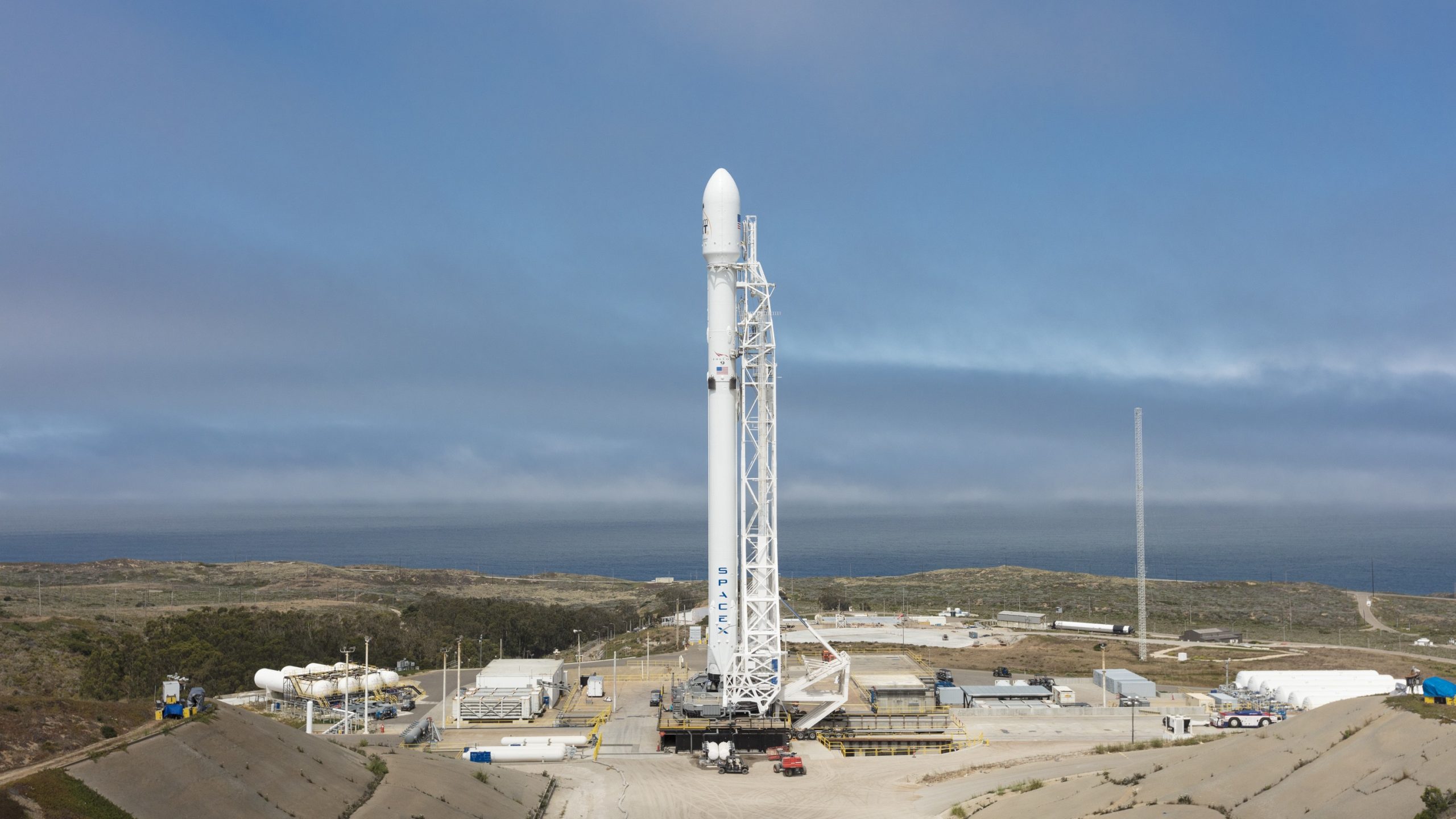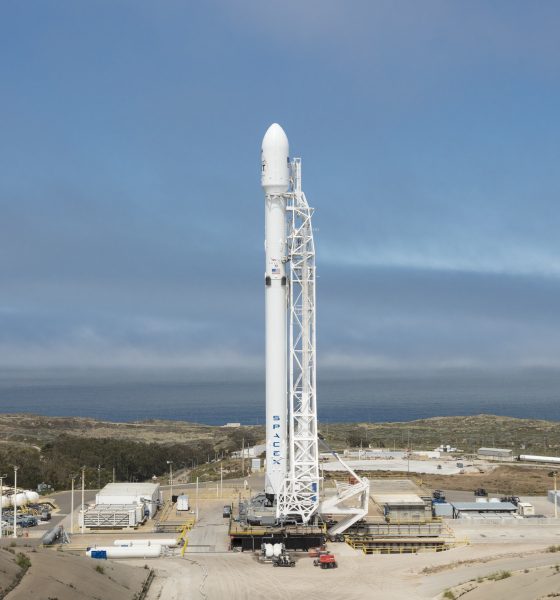

News
SpaceX set for second weekend launch, new titanium grid fins to be tested
After a highly successful Friday launch and recovery of a reused Falcon 9, a second vehicle is preparing to launch on the opposite coast of the United States. Scheduled to lift off at precisely 1:25 p.m. PST, this mission will see a brand new Falcon 9 lift Iridium’s second set of ten NEXT satellites, after which the first stage will attempt to land in the Pacific Ocean aboard Just Read The Instructions, SpaceX’s West Coast drone ship.
If the schedule holds, the 46 hours separation between launches will make SpaceX one of very few entities to have launched the same vehicle in such close succession. While Russia/USSR and the Republic of China have tended to routinely launch missions with as few as a handful of hours in between, it is extremely rare in the United States, and such an accomplishment will likely make SpaceX the second private company to ever conduct two launches in under 48 hours.
This turnaround, which COO Gwynne Shotwell clarified could safely be as few as 24 hours, bodes extremely well for SpaceX’s and Musk’s goal of being able to launch every 24 hours. With the COO of the company already under the impression that 24 hours would be safely and reliably achievable, all that lies in the way of 24 hour cadence is pad availability. With current cadence suggesting that at least two weeks of down time is needed after a launch to verify pad health, the late-fall reactivation of Launch Complex 40 and eventual activation of SpaceX’s planned Boca Chica, Texas launch facility will give SpaceX three general-purpose pads and one limited use-case pad (Vandenberg Air Force Base) to launch from by late 2018 or early 2019. Three general purpose pads would allow SpaceX to launch every four or five days, assuming no improvements in pad resilience and autonomy, and this weekend’s back to back launches will demonstrate that SpaceX is easily capable of fully taking advantage of those three (or four) pads once they are all active.

Falcon 9’s fancy new titanium grid fins. (SpaceX/Instagram)
As for the launch today, it will debut some intriguing new hardware intended to improve the ease of reusability for the first stage. Musk offered a tweet storm last night and SpaceX one or two photos to explain the utility of the vehicles distinctive and unusual black grid fins. Ready to launch in just over an hour from Vandenberg Air Force Base, Falcon 9 and its new grid fins will place the next ten iridium NEXT satellites in Low Earth Orbit. The first stage will then proceed to the autonomous spaceport drone ship Just Read The Instructions, while testing its rather fancy titanium grid fins. Considerably larger than their aluminum predecessors, this new iteration of grid fins will is intended to both provide more control authority and glide capability in anticipation of the Falcon Heavy, while also offering improve resilience to the extreme heat and forces grid fins must necessarily cope with during reentry. You may have noted grid fins appearing to glow red and orange with the heat of reentry in past live coverage, and recovered stages demonstrate just how harsh high temperatures can be to aluminum. Titanium is famously resistant to heat and will thus optimally be able to be reused with no refurbishment or replacement whatsoever.
With the launch just over an hour out and no current known issues, you can watch SpaceX’s regularly amazing live coverage of the launch at spacex.com/webcast.

News
Tesla starts showing how FSD will change lives in Europe
Local officials tested the system on narrow country roads and were impressed by FSD’s smooth, human-like driving, with some calling the service a game-changer for everyday life in areas that are far from urban centers.

Tesla has launched Europe’s first public shuttle service using Full Self-Driving (Supervised) in the rural Eifelkreis Bitburg-Prüm region of Germany, demonstrating how the technology can restore independence and mobility for people who struggle with limited transport options.
Local officials tested the system on narrow country roads and were impressed by FSD’s smooth, human-like driving, with some calling the service a game-changer for everyday life in areas that are far from urban centers.
Officials see real impact on rural residents
Arzfeld Mayor Johannes Kuhl and District Administrator Andreas Kruppert personally tested the Tesla shuttle service. This allowed them to see just how well FSD navigated winding lanes and rural roads confidently. Kruppert said, “Autonomous driving sounds like science fiction to many, but we simply see here that it works totally well in rural regions too.” Kuhl, for his part, also noted that FSD “feels like a very experienced driver.”
The pilot complements the area’s “Citizen Bus” program, which provides on-demand rides for elderly residents who can no longer drive themselves. Tesla Europe shared a video of a demonstration of the service, highlighting how FSD gives people their freedom back, even in places where public transport is not as prevalent.
What the Ministry for Economic Affairs and Transport says
Rhineland-Palatinate’s Minister Daniela Schmitt supported the project, praising the collaboration that made this “first of its kind in Europe” possible. As per the ministry, the rural rollout for the service shows FSD’s potential beyond major cities, and it delivers tangible benefits like grocery runs, doctor visits, and social connections for isolated residents.
“Reliable and flexible mobility is especially vital in rural areas. With the launch of a shuttle service using self-driving vehicles (FSD supervised) by Tesla in the Eifelkreis Bitburg-Prüm, an innovative pilot project is now getting underway that complements local community bus services. It is the first project of its kind in Europe.
“The result is a real gain for rural mobility: greater accessibility, more flexibility and tangible benefits for everyday life. A strong signal for innovation, cooperation and future-oriented mobility beyond urban centers,” the ministry wrote in a LinkedIn post.
News
Tesla China quietly posts Robotaxi-related job listing
Tesla China is currently seeking a Low Voltage Electrical Engineer to work on circuit board design for the company’s autonomous vehicles.

Tesla has posted a new job listing in Shanghai explicitly tied to its Robotaxi program, fueling speculation that the company is preparing to launch its dedicated autonomous ride-hailing service in China.
As noted in the listing, Tesla China is currently seeking a Low Voltage Electrical Engineer to work on circuit board design for the company’s autonomous vehicles.
Robotaxi-specific role
The listing, which was shared on social media platform X by industry watcher @tslaming, suggested that Tesla China is looking to fill the role urgently. The job listing itself specifically mentions that the person hired for the role will be working on the Low Voltage Hardware team, which would design the circuit boards that would serve as the nervous system of the Robotaxi.
Key tasks for the role, as indicated in the job listing, include collaboration with PCB layout, firmware, mechanical, program management, and validation teams, among other responsibilities. The role is based in Shanghai.
China Robotaxi launch
China represents a massive potential market for robotaxis, with its dense urban centers and supportive policies in select cities. Tesla has limited permission to roll out FSD in the country, though despite this, its vehicles have been hailed as among the best in the market when it comes to autonomous features. So far, at least, it appears that China supports Tesla’s FSD and Robotaxi rollout.
This was hinted at in November, when Tesla brought the Cybercab to the 8th China International Import Expo (CIIE) in Shanghai, marking the first time that the autonomous two-seater was brought to the Asia-Pacific region. The vehicle, despite not having a release date in China, received a significant amount of interest among the event’s attendees.
Elon Musk
Elon Musk and Tesla AI Director share insights after empty driver seat Robotaxi rides
The executives’ unoccupied tests hint at the rapid progress of Tesla’s unsupervised Robotaxi efforts.

Tesla CEO Elon Musk and AI Director Ashok Elluswamy celebrated Christmas Eve by sharing personal experiences with Robotaxi vehicles that had no safety monitor or occupant in the driver’s seat. Musk described the system’s “perfect driving” around Austin, while Elluswamy posted video from the back seat, calling it “an amazing experience.”
The executives’ unoccupied tests hint at the rapid progress of Tesla’s unsupervised Robotaxi efforts.
Elon and Ashok’s firsthand Robotaxi insights
Prior to Musk and the Tesla AI Director’s posts, sightings of unmanned Teslas navigating public roads were widely shared on social media. One such vehicle was spotted in Austin, Texas, which Elon Musk acknowleged by stating that “Testing is underway with no occupants in the car.”
Based on his Christmas Eve post, Musk seemed to have tested an unmanned Tesla himself. “A Tesla with no safety monitor in the car and me sitting in the passenger seat took me all around Austin on Sunday with perfect driving,” Musk wrote in his post.
Elluswamy responded with a 2-minute video showing himself in the rear of an unmanned Tesla. The video featured the vehicle’s empty front seats, as well as its smooth handling through real-world traffic. He captioned his video with the words, “It’s an amazing experience!”
Towards Unsupervised operations
During an xAI Hackathon earlier this month, Elon Musk mentioned that Tesla owed be removing Safety Monitors from its Robotaxis in Austin in just three weeks. “Unsupervised is pretty much solved at this point. So there will be Tesla Robotaxis operating in Austin with no one in them. Not even anyone in the passenger seat in about three weeks,” he said. Musk echoed similar estimates at the 2025 Annual Shareholder Meeting and the Q3 2025 earnings call.
Considering the insights that were posted Musk and Elluswamy, it does appear that Tesla is working hard towards operating its Robotaxis with no safety monitors. This is quite impressive considering that the service was launched just earlier this year.








